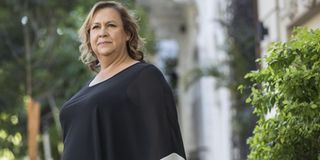Pablo Escobar’s widow: How we escaped drug ring's dragnet

Victoria Eugenia Henao, the widow of drug lord Pablo Escobar. In her memoir, she discusses how she extended an olive branch to his rival when they went after her family.
What you need to know:
- In her memoir, Victoria Eugenia Henao discusses how she extended an olive branch to her husband's rivals.
- She finally fled to Mozambique and finally settled in Argentina with her family.
On December 2, 1993, after a decade as a fugitive and later a convict at his self-constructed prison La Catedral, Pablo Emilio Escobar was eventually killed.
The Search Block, a Colombian special operations unit funded by the Colombian government and equipped by the Central Intelligence Agency and the Drug Enforcement Agency, tracked and finally terminated the world's most infamous cocaine drug lord and mass murderer, after an incisive 16-month final search effort.
In the Forbes magazine's first-ever billionaire issue on October 5, 1987, Escobar was ranked the seventh wealthiest person on earth. On the day of his death, he was housed in a modest apartment in Antioquia, in his hometown of Medellin.
He was in the middle of a telephone conversation with his then 16-year-old son Juan Pablo. A shootout ensued between Escobar, his chaperone Lemon and the Columbian police, before his death on the roof.
On December 5, 1993, Don Fabio Ochoa Restrepo visited Juan, his nine-year-old sister Manuela and mother Maria Victoria Eugenia Henao at the Hotel Residencias in Bogota.
Don Fabio was the father of mega drug traffickers – the Ochoa brothers Jorge, David and Fabio Junior. The Ochoa brothers had been part of the world's largest drug exporting organisation, the Medellin cartel, alongside Escobar.
Don Fabio informed Maria that Fidel Castano, leader of Los Pepes, a merciless vigilante group, still intended to kill her and her children. Castano was Escobar's former drug trafficking friend.
Los Pepes comprised those who had been persecuted by Escobar. They created a lethal paramilitary faction that engaged in a destructive war with Escobar, eventually breaking his sophisticated trafficking network and financial muscle.
Los Pepes had been funded by Escobar’s fierce drug dealing rivals, Cali cartel, from the City of Cali, southwest of the capital, Bogota.
Shortly before Escobar’s death, Los Pepes had issued an ultimatum to him to surrender or they would begin killing his relatives. This led Columbian Attorney General Gustavo De Greiff, in practising his independence from the Executive and issuing an order to place Escobar’s wife Maria and her children in heavily armed protective custody.
In her memoir, Pablo and Me: My Life with Escobar, Maria expresses how she extended an olive branch to rival cartels and Castano. She began visiting Escobar’s former affiliates and adversaries.
On her son Juan's visit to La Picota prison, one of Escobar’s most brutal killers, Leonidas Vargas, approached Juan and informed him that he needed $1 million that Escobar owed him. Unfortunately, Maria had no money.
Coincidentally, Attorney General De Greiff returned one of Escobar’s luxurious planes that had been confiscated at Medellín’s Olaya Herrera Airport to Maria. She offered it to Vargas as payment for the debt and he accepted.

The cover of Victoria Eugenia Henao's memoir. She is the widow of drug lord Pablo Escobar.
However, the largest threat Maria faced was by Miguel and Gilberto Rodriguez. The brothers were the bosses of the Cali cartel that had funded Los Pepes.
They had hated Escobar and were responsible for the bombing of his Medellin residence, called Monaco building, on January 13, 1988, in an attempt to assassinate Maria and her children.
Juan had publicly revealed to the authorities then that the Cali cartel was behind the attack. An investigation had proceeded against the brothers and the Cali cartel then ordered Juan to legally retract that statement, which he did in the presence of the cartel's lawyer and the prosecutor.
The Cali cartel sent one of their trustees to Medellin to instruct Maria that it would cost her dearly, if she and her daughter Manuela had to stay alive. During their war with Escobar, they had incurred $20 million expenses.
They ordered Maria to sign over Escobar’s assets to them and Castano. They, however, insisted that they would kill Juan.
In fear, Maria paid 50 per cent of Escobar’s debt in kind, using assets that had been confiscated by the attorney general’s office and returned to her.
The remaining half was paid in properties that were not tangled in legal proceedings and could be liquidated, including a 250,000-acre farm in the Orinoquia region.
The list also had airplanes; helicopters; personal vehicles, including Mercedes-Benzes, BMWs and Jaguars; new and old models of high-end motorcycles; boats; and jet skis. However, the famous $60 million Hacienda Napoles, a theme park, was repossessed by the Columbian state.
The Cali cartel left Maria the Monaco, Dallas Texas, and Ovni buildings, which Escobar had entrusted to his children and which his mother Hermilda tried to steal from them after his death.
Escobar's brother, Roberto, pilfered $3 million that he had entrusted to him for Maria and her children. Escobar’s conniving sister, Gloria, then stole the $3 million he had hidden in a bunker in one of his remote houses, for the upkeep of his children.
The Cali cartel eventually spared Juan’s life. After being rejected by 17 diplomatic representations in Bogota, Mozambique accepted to accommodate Maria.
She secretly flew to the capital, Maputo, on December 14, 1994, with her children after changing their names, but eventually relocated to Buenos Aires, Argentina.
The reviewer is a novelist, Big Brother Africa 2 Kenyan representative and founder of Jeff's Fitness Centre; @jeffbigbrother





